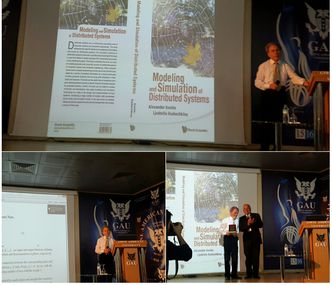
FACULTY OF ENGINEERING
News
GAÜ'DEN

First Keynote Speaker Prof. Dr. Alexander Kostin gave his speech.
Extended Petri nets for modeling and simulation of information systems
There are a number of specific theoretical methods and frameworks available for a formalized description, modeling and investigation of complex information systems. These methods and frameworks include, but are not limited to finite state machines (FSM), queuing networks, the communicating sequential processes (CSP) model, the calculus of communicating systems (CCS), the temporal logic, and Petri nets. An efficient theoretical framework for information systems should have simple means to express different aspects related to the parallelism of events and processes, their synchronization, properties of safety and liveness, and the formal methods to prove these properties. The framework should give the possibility to perform the analysis of reachable states in such systems considered as discrete-event systems. Finally, the required framework must provide a graphical representation and description of system models and their components and be supported by corresponding tools for designers. All these capabilities are available in Petri nets that originally have been proposed by a German scientist Karl Petri in 1962. These nets are considered as general or classical Petri nets. In this presentation, initially general information is given about classical Petri nets. Unfortunately, general Petri nets do not represent a universal algorithmic system and therefore cannot be used for simulation of dynamic systems. The impossibility of the use of general Petri nets for simulation purposes gave rise to the development of their different extensions such as Petri nets with inhibitor arcs, timed Petri nets, stochastic Petri nets, colored Petri nets, predicate/transition Petri nets that allow for both qualitative and quantitative analyses. In this presentation, I will concentrate on a class of extended Petri nets (EPN) that has been developed by our research group in Moscow since 1978, implemented in the form of a few versions of simulation system and used in a number of published papers and MS and PhD theses in Moscow, EMU and GAU. After explanation of the concept of elementary net, the basic set of elementary nets is introduced. This set is sufficient to build models of dynamic systems of any complexity. The use of extended Petri nets is illustrated with a few examples of solved models of queuing systems. A brief information is given about the simulation system Winsim that implements all stages of the development and running of models in terms of extended Petri nets. A reference to our book is given that contains detailed information about extended Petri nets, software of Winsim and numerous examples of solved simulation models.

